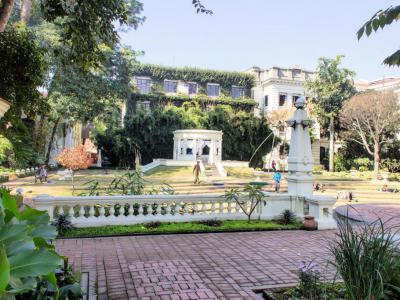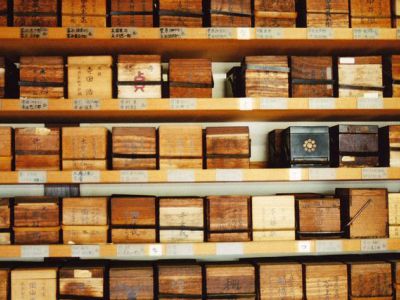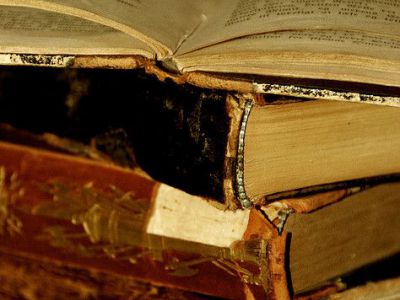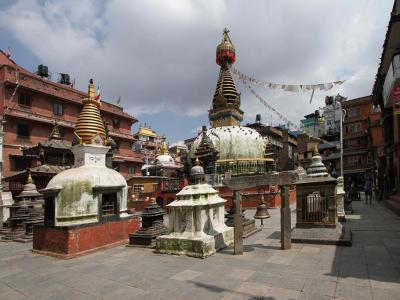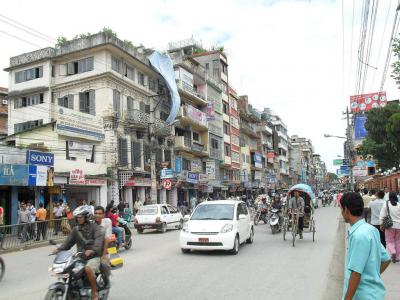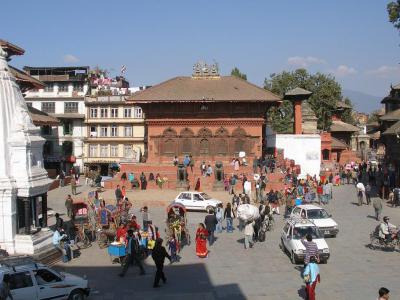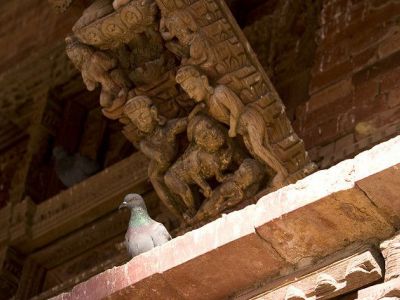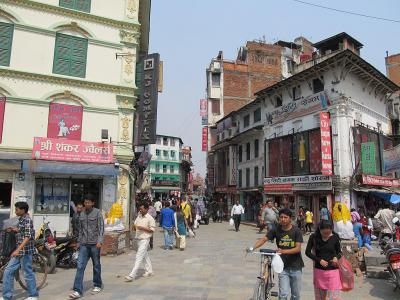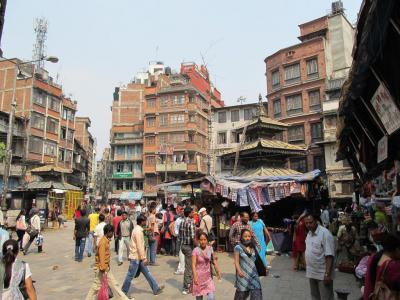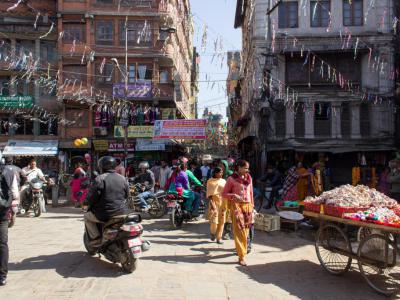Custom Walk in Kathmandu, Nepal by dustyparson_dcf96 created on 2025-05-09
Guide Location: Nepal » Kathmandu
Guide Type: Custom Walk
# of Sights: 11
Tour Duration: 3 Hour(s)
Travel Distance: 4.7 Km or 2.9 Miles
Share Key: R7D2T
Guide Type: Custom Walk
# of Sights: 11
Tour Duration: 3 Hour(s)
Travel Distance: 4.7 Km or 2.9 Miles
Share Key: R7D2T
How It Works
Please retrieve this walk in the GPSmyCity app. Once done, the app will guide you from one tour stop to the next as if you had a personal tour guide. If you created the walk on this website or come to the page via a link, please follow the instructions below to retrieve the walk in the app.
Retrieve This Walk in App
Step 1. Download the app "GPSmyCity: Walks in 1K+ Cities" on Apple App Store or Google Play Store.
Step 2. In the GPSmyCity app, download(or launch) the guide "Kathmandu Map and Walking Tours".
Step 3. Tap the menu button located at upper right corner of the "Walks" screen and select "Retrieve custom walk". Enter the share key: R7D2T
1) Garden of Dreams (must see)
The Garden of Dreams, located in Kaiser Mahal, Kathmandu, is a historical and architectural marvel initially established in the early 1920s. Designed by Kishore Narshingh, a notable landscape architect, the Garden was built for Field Marshal Kaiser Sumsher Rana. It spans 6,895 square meters and features a Neo-classical style reminiscent of the Edwardian gardens popular in England during King Edward VII's reign. The design includes formal and axial arrangements of architectural elements combined with more naturalistic planting schemes.
This garden, also known as the Garden of Six Seasons, reflects its name through its six pavilions, each dedicated to a different season in Nepal. These pavilions are complemented by three other main structures, an amphitheater, and various decorative elements such as fountains, sunken flower gardens with central ponds, pergolas, and urns. The architectural features suggest influences from pattern books, adapted with local nuances.
Despite its initial grandeur and sophistication-making it one of the most prestigious private gardens of its time-the Garden of Dreams fell into neglect after the death of Kaiser Sumsher in the mid-1960s. It was left unattended until a significant restoration project funded by the Austrian government brought it back to life. However, today, only half of the original garden remains.
In a dramatic turn of events in 1998, when the garden was at risk of being demolished for commercial development, intervention by Minister of Education Arjun Narsingha KC, following advice from conservationist Karna Shakya, saved it. It was then opened to the public under the new moniker, "The Garden of Dreams."
Located strategically across from the former Royal Palace and near the Thamel tourist district, the Garden of Dreams now serves not only as a historical site but also as a peaceful retreat for both locals and tourists in the heart of Kathmandu.
This garden, also known as the Garden of Six Seasons, reflects its name through its six pavilions, each dedicated to a different season in Nepal. These pavilions are complemented by three other main structures, an amphitheater, and various decorative elements such as fountains, sunken flower gardens with central ponds, pergolas, and urns. The architectural features suggest influences from pattern books, adapted with local nuances.
Despite its initial grandeur and sophistication-making it one of the most prestigious private gardens of its time-the Garden of Dreams fell into neglect after the death of Kaiser Sumsher in the mid-1960s. It was left unattended until a significant restoration project funded by the Austrian government brought it back to life. However, today, only half of the original garden remains.
In a dramatic turn of events in 1998, when the garden was at risk of being demolished for commercial development, intervention by Minister of Education Arjun Narsingha KC, following advice from conservationist Karna Shakya, saved it. It was then opened to the public under the new moniker, "The Garden of Dreams."
Located strategically across from the former Royal Palace and near the Thamel tourist district, the Garden of Dreams now serves not only as a historical site but also as a peaceful retreat for both locals and tourists in the heart of Kathmandu.
2) Aroma Garden
Situated in the vibrant heart of Kathmandu, Aroma Garden is a boutique located at the bustling intersection of Thamel Road and Bhagwan Bahal in Thamel, a district known for its dynamic street life and cultural allure. Aroma Garden stands out as a premier destination for those seeking a sensory experience through the scents of Nepal.
The boutique specializes in a variety of aromatic products, including incense, essential oils, and soaps, which are renowned for their exquisite fragrances and high-quality ingredients. The incense sold here, often used in Nepalese temples, is crafted from natural materials such as vegetables and oils, ensuring that it is safe to use at home without health risks.
Aroma Garden is celebrated as the sweetest-smelling shop in Banaras, offering more than just olfactory pleasures. It serves as a one-stop shop for a wide range of aromatic and herbal products. Shoppers can find everything from dhoop (a type of incense) and Himalayan soaps to essential oils and other items that enhance both the environment and personal well-being.
In addition to its core offerings, Aroma Garden provides a vast selection of natural perfumes, lip balms, wild honey, perfume creams, organic coffee, and tea. The store also offers a variety of Nepali products that make perfect souvenirs, capturing the essence of Nepal in each item.
Aroma Garden prides itself on delivering top-notch service with a focus on skincare, hair treatments, and inner health. Visitors are encouraged to explore the shop's diverse range of products, each promising to enrich the senses and contribute to a healthier lifestyle.
The boutique specializes in a variety of aromatic products, including incense, essential oils, and soaps, which are renowned for their exquisite fragrances and high-quality ingredients. The incense sold here, often used in Nepalese temples, is crafted from natural materials such as vegetables and oils, ensuring that it is safe to use at home without health risks.
Aroma Garden is celebrated as the sweetest-smelling shop in Banaras, offering more than just olfactory pleasures. It serves as a one-stop shop for a wide range of aromatic and herbal products. Shoppers can find everything from dhoop (a type of incense) and Himalayan soaps to essential oils and other items that enhance both the environment and personal well-being.
In addition to its core offerings, Aroma Garden provides a vast selection of natural perfumes, lip balms, wild honey, perfume creams, organic coffee, and tea. The store also offers a variety of Nepali products that make perfect souvenirs, capturing the essence of Nepal in each item.
Aroma Garden prides itself on delivering top-notch service with a focus on skincare, hair treatments, and inner health. Visitors are encouraged to explore the shop's diverse range of products, each promising to enrich the senses and contribute to a healthier lifestyle.
3) Nepal Book Depot
Nepal Book Depot, conveniently located at the intersection of Kathmandu Guesthouse Road and Chakshibari Marg in Kathmandu, is a notable destination for book lovers seeking both Nepalese and international titles at some of the most competitive prices in the area. This bookshop offers an extensive selection of books covering a diverse array of subjects including Carpets, Mountaineering, Wildlife, Literature, Yoga, Ayurveda, and Health, catering to a wide range of interests.
For travelers and enthusiasts of the Himalayas, Tibet, India, and Nepal, the Nepal Book Depot stands out as an exceptional source of travel books and guides. What sets this bookstore apart is not just its affordable pricing, which is open to negotiation, but also its collection of rare books that are often unavailable on major platforms like Amazon. This makes it a treasure trove for those in search of unique and hard-to-find literature. Whether you're a casual reader, a serious collector, or someone planning an adventure in the region, Nepal Book Depot offers a rich repository of knowledge and stories waiting to be discovered.
For travelers and enthusiasts of the Himalayas, Tibet, India, and Nepal, the Nepal Book Depot stands out as an exceptional source of travel books and guides. What sets this bookstore apart is not just its affordable pricing, which is open to negotiation, but also its collection of rare books that are often unavailable on major platforms like Amazon. This makes it a treasure trove for those in search of unique and hard-to-find literature. Whether you're a casual reader, a serious collector, or someone planning an adventure in the region, Nepal Book Depot offers a rich repository of knowledge and stories waiting to be discovered.
4) Kathesimbu Stupa
Kathesimbu Stupa (Kaathe Swayambhu Shree Gha Chaitya) is an important Tibetan pilgrimage site located in the heart of Kathmandu. Built around 1650 AD, this stupa serves as a miniature replica of the famed Swayambhunath Stupa, embodying similar spiritual significance.
The stupa is encircled by an array of smaller chaityas, statues, and inscriptions, along with an ancient cloister reminiscent of a Tibetan monastery. A notable feature in front of the stupa is a statue of Avalokiteshvara, a bodhisattva embodying compassion, which enhances the sanctity of the site. The stupa architecture includes a spire with 13 steps, symbolizing the 13 stages of the spiritual journey culminating in Nirvana, underscoring the site's deep Buddhist symbolism.
According to local legends, the stupa has a miraculous origin story involving Acharya Vak-vajra, a revered monk from the Kwa-Baha monastic community. During a pilgrimage along the Ganges, Vak-vajra was challenged by the king of Benaras to prove his spiritual powers. In response, Vak-vajra levitated the chaitya and transported it to Kathmandu. Another tradition suggests the stupa was constructed using leftover materials from Swayambhunath, tying its creation closely to this major Buddhist monument.
Historically, the stupa is first mentioned in an inscription from 1552 AD, detailing the donation of its golden pinnacle by Megharaja to commemorate his deceased son and the establishment of a guthi (a traditional communal trust) for performing annual rituals. This guthi maintains strong links with the local Kwa-baha priests.
Today, Kathesimbu Stupa remains a focal point for pilgrims who, unable to visit the more remote Swayambhunath, find equivalent spiritual benefit in this accessible and historic site in Kathmandu.
The stupa is encircled by an array of smaller chaityas, statues, and inscriptions, along with an ancient cloister reminiscent of a Tibetan monastery. A notable feature in front of the stupa is a statue of Avalokiteshvara, a bodhisattva embodying compassion, which enhances the sanctity of the site. The stupa architecture includes a spire with 13 steps, symbolizing the 13 stages of the spiritual journey culminating in Nirvana, underscoring the site's deep Buddhist symbolism.
According to local legends, the stupa has a miraculous origin story involving Acharya Vak-vajra, a revered monk from the Kwa-Baha monastic community. During a pilgrimage along the Ganges, Vak-vajra was challenged by the king of Benaras to prove his spiritual powers. In response, Vak-vajra levitated the chaitya and transported it to Kathmandu. Another tradition suggests the stupa was constructed using leftover materials from Swayambhunath, tying its creation closely to this major Buddhist monument.
Historically, the stupa is first mentioned in an inscription from 1552 AD, detailing the donation of its golden pinnacle by Megharaja to commemorate his deceased son and the establishment of a guthi (a traditional communal trust) for performing annual rituals. This guthi maintains strong links with the local Kwa-baha priests.
Today, Kathesimbu Stupa remains a focal point for pilgrims who, unable to visit the more remote Swayambhunath, find equivalent spiritual benefit in this accessible and historic site in Kathmandu.
5) New Road
New Road stands as the bustling financial heart and vibrant main street in Kathmandu. It denotes a narrow two-lane thoroughfare nestled within the heart of the city, along with its surrounding vicinity. Positioned close to the midpoint of Kathmandu's ring road and the historic center, including Kathmandu Durbar Square, also known as Basantapur, it holds significant prominence within the urban landscape.
Functioning as one of the primary commercial hubs, New Road teems with activity, offering a plethora of imported luxury goods of premium quality. Among its array of offerings, several quaint shops specialize in traditional Nepali musical instruments like fiddles and flutes, while also featuring iconic souvenirs such as the khukri - a ceremonial knife.
This road's inception dates back to the era of Prime Minister Juddha Shumsher Jung Bahadur Rana, following the devastation wrought by the 1934 Nepal–India earthquake in the Kathmandu Valley. Originally christened Juddha Sadak in his honor, it also holds historical significance as the former Kings Way of Nepal, leading to the erstwhile royal palace within Kathmandu Durbar Square, a UNESCO World Heritage Site.
New Road's eastern terminus hosts the headquarters of Nepal Airlines, adjacent to New Road Gate, marking the road's outset at the intersection with Kantipath. At the road's westernmost roundabout stands a statue commemorating Juddha Shumsher Jung Bahadur Rana. Moreover, New Road accommodates the head offices of Gorkhapatra Sansthan and Nepal Bank Limited, alongside the scenic Bhughol Park situated at its southwestern corner.
Functioning as one of the primary commercial hubs, New Road teems with activity, offering a plethora of imported luxury goods of premium quality. Among its array of offerings, several quaint shops specialize in traditional Nepali musical instruments like fiddles and flutes, while also featuring iconic souvenirs such as the khukri - a ceremonial knife.
This road's inception dates back to the era of Prime Minister Juddha Shumsher Jung Bahadur Rana, following the devastation wrought by the 1934 Nepal–India earthquake in the Kathmandu Valley. Originally christened Juddha Sadak in his honor, it also holds historical significance as the former Kings Way of Nepal, leading to the erstwhile royal palace within Kathmandu Durbar Square, a UNESCO World Heritage Site.
New Road's eastern terminus hosts the headquarters of Nepal Airlines, adjacent to New Road Gate, marking the road's outset at the intersection with Kantipath. At the road's westernmost roundabout stands a statue commemorating Juddha Shumsher Jung Bahadur Rana. Moreover, New Road accommodates the head offices of Gorkhapatra Sansthan and Nepal Bank Limited, alongside the scenic Bhughol Park situated at its southwestern corner.
6) Durbar Square (must see)
Durbar Square is a royal palace complex in Kathmandu. The square's full name is Hanuman Dhoka Durbar Square, named after the statue of Hanuman, a Hindu god, situated at the entrance.
The first royal palaces were constructed during the third century. Due to repeat reconstruction, nothing is left of those first buildings. Several structures around Durbar Square collapsed in 2015 when a 7.9 magnitude earthquake struck the region. The oldest building destroyed was the 7th-century Kasthamandap, a three-storied temple enshrining the deity of Gorakhnath.
It is thought that the existing palaces were built in the 10th century by Gunakamadeva, the ruler who founded the city of Kathmandu. They were not declared royal palaces until sometime during the reign of King Ratna Malla in the late 15th or early 16th century. The Durbar Square was the center of power until 1896 but continues to be used for coronations.
Structures around the complex include the 16th-century temples of Jagannath, Kotilingeshwara, Mahadev, Mahendreshwara, and Taleju. Other temples are the 18th-century Bhagavati Temple and the 17th-century Degutale Temple.
The Gaddi Durbar Neoclassical Palace was built in Durbar Square in 1908. It was designed in European architectural style with Greek columns and white plaster. The palace was used for coronations and to welcome heads of state from other countries. The Kumari Chock, a red-colored royal palace at the southern end of Durbar Square, is an even more popular attraction. It consists of the Raj Kumari or the Living Goddess, a preadolescence girl in a gilded cage, thought to be the human incarnation of the goddess Durga.
The Hanuman Dhoka Palace is open to visitors. Tourists can see the staterooms and the museums. The two museums inside the Hanuman Dhoka Palace are the King Tribhuvan Memorial Museum and the Mahendra Museum.
Durbar Square is a UNESCO World Heritage Site.
The first royal palaces were constructed during the third century. Due to repeat reconstruction, nothing is left of those first buildings. Several structures around Durbar Square collapsed in 2015 when a 7.9 magnitude earthquake struck the region. The oldest building destroyed was the 7th-century Kasthamandap, a three-storied temple enshrining the deity of Gorakhnath.
It is thought that the existing palaces were built in the 10th century by Gunakamadeva, the ruler who founded the city of Kathmandu. They were not declared royal palaces until sometime during the reign of King Ratna Malla in the late 15th or early 16th century. The Durbar Square was the center of power until 1896 but continues to be used for coronations.
Structures around the complex include the 16th-century temples of Jagannath, Kotilingeshwara, Mahadev, Mahendreshwara, and Taleju. Other temples are the 18th-century Bhagavati Temple and the 17th-century Degutale Temple.
The Gaddi Durbar Neoclassical Palace was built in Durbar Square in 1908. It was designed in European architectural style with Greek columns and white plaster. The palace was used for coronations and to welcome heads of state from other countries. The Kumari Chock, a red-colored royal palace at the southern end of Durbar Square, is an even more popular attraction. It consists of the Raj Kumari or the Living Goddess, a preadolescence girl in a gilded cage, thought to be the human incarnation of the goddess Durga.
The Hanuman Dhoka Palace is open to visitors. Tourists can see the staterooms and the museums. The two museums inside the Hanuman Dhoka Palace are the King Tribhuvan Memorial Museum and the Mahendra Museum.
Durbar Square is a UNESCO World Heritage Site.
7) Jagganath Temple
The Jagannath Temple is a historic structure located in Hanuman Dhoka Darbar Square in Kathmandu. It is one of the oldest temples in the square, with a foundation date traced back to 1563, as marked at the base of the temple's central statue. This date places the temple's construction during the early reign of Mahendra Malla (1560–1574), correcting earlier misconceptions and attributing it to King Pratap Malla. Architectural historian Michael Hutt has helped clarify this timeline, highlighting its significance in the architectural history of the region.
The temple exemplifies Newar architecture, constructed with brick and wood and situated on a low plinth. Its design is comparable to the contemporary Char Narayan temple in Patan, featuring outer walls with three-doored portals. These portals lead to an ambulatory around a central cella, which is accessible only to priests. The temple’s layout includes blocked passageways at specific corners to distinctly separate the main shrine from the central image.
Architectural and decorative elements of the Jagannath Temple are particularly notable. It features four small two-tiered towers at each corner. The temple houses a ground floor of 8.3 meters on each side, surmounted by two tiers of roofs upheld by 48 intricately carved wooden brackets. These brackets are celebrated for depicting deities with four heads and eight arms, representing the twenty-four forms of Vishnu, and are considered some of the finest carvings in the palace square.
Despite the artistic value of the main carvings, the temple also features friezes of lesser quality below each bracket that depict erotic scenes involving humans and animals. These have been critiqued for their lack of artistic merit compared to the major figures and have faded over time, moving from vibrant colors to a monochrome appearance as noted in recent assessments.
The temple exemplifies Newar architecture, constructed with brick and wood and situated on a low plinth. Its design is comparable to the contemporary Char Narayan temple in Patan, featuring outer walls with three-doored portals. These portals lead to an ambulatory around a central cella, which is accessible only to priests. The temple’s layout includes blocked passageways at specific corners to distinctly separate the main shrine from the central image.
Architectural and decorative elements of the Jagannath Temple are particularly notable. It features four small two-tiered towers at each corner. The temple houses a ground floor of 8.3 meters on each side, surmounted by two tiers of roofs upheld by 48 intricately carved wooden brackets. These brackets are celebrated for depicting deities with four heads and eight arms, representing the twenty-four forms of Vishnu, and are considered some of the finest carvings in the palace square.
Despite the artistic value of the main carvings, the temple also features friezes of lesser quality below each bracket that depict erotic scenes involving humans and animals. These have been critiqued for their lack of artistic merit compared to the major figures and have faded over time, moving from vibrant colors to a monochrome appearance as noted in recent assessments.
8) Hanuman Dhoka Palace (must see)
Hanuman Dhoka Palace is a series of structures in Durbar Square. The five acres of the palace grounds include the Royal Palace, Taleju Temple, Hanuman Gate, the Panch Mukhi Hanuman Temple, and the Basantapur Tower.
The palace is named after the statue of the Hindu deity Hanuman, which guards the front door. Hanuman refers to the deity itself, while the word "Dhoke" is Nepali for "door."
The oldest part of the palace is the eastern wing and its courtyards. This portion was built in the mid-1500s and then expanded 100 years later by King Pratap Malla. The towers were added in 1768.
A stone drinking fountain outside of the palace is inscribed in 15 languages. It states that anyone who understands all 15 languages will drink milk, rather than water, from the fountain. There is also a stone sculpture, added in 1673, representing Lord Narasimha, the fourth avatar of the Hindu god Vishnu.
Three museums are located within the palace grounds. The Tribhuvan Museum offers items belonging to King Birendra, the tenth Shah Ruler and the King of Nepal from 1972 until 2001, including stone carvings, wooden carvings, weapons, furniture, coins, and jewels. The King Mahendra Memorial Museum displays his thrones. Mahendra was the King of Nepal from 1955 until he died in 1972. The primary museum, the Hanuman Dhoka Palace Museum, exhibits information and items from the Shah Dynasty and the history of Nepal.
The palace and its grounds were severely damaged by an earthquake in 2015.
The palace is named after the statue of the Hindu deity Hanuman, which guards the front door. Hanuman refers to the deity itself, while the word "Dhoke" is Nepali for "door."
The oldest part of the palace is the eastern wing and its courtyards. This portion was built in the mid-1500s and then expanded 100 years later by King Pratap Malla. The towers were added in 1768.
A stone drinking fountain outside of the palace is inscribed in 15 languages. It states that anyone who understands all 15 languages will drink milk, rather than water, from the fountain. There is also a stone sculpture, added in 1673, representing Lord Narasimha, the fourth avatar of the Hindu god Vishnu.
Three museums are located within the palace grounds. The Tribhuvan Museum offers items belonging to King Birendra, the tenth Shah Ruler and the King of Nepal from 1972 until 2001, including stone carvings, wooden carvings, weapons, furniture, coins, and jewels. The King Mahendra Memorial Museum displays his thrones. Mahendra was the King of Nepal from 1955 until he died in 1972. The primary museum, the Hanuman Dhoka Palace Museum, exhibits information and items from the Shah Dynasty and the history of Nepal.
The palace and its grounds were severely damaged by an earthquake in 2015.
9) Makhan Tole Street
Makhan Tole, also known as Makhan Tol, is a vibrant and culturally rich street located in the heart of Kathmandu, Nepal, just north of the iconic Durbar Square. This area is a must-visit for those who are passionate about exploring the cultural and artistic heritage of Kathmandu. It offers a deep dive into the local fine arts scene, especially known for its shops selling thangka and paubha paintings.
Thangka, a traditional form of Tibetan art, features detailed embroidery on silk cloth, depicting Buddhist deities or mandalas, which are spiritual and ritual symbols in Hinduism and Buddhism representing the universe. Paubha is the Nepalese counterpart to thangka and involves scroll paintings that are highly revered in local culture.
Makhan Tole stretches from the northern part of Durbar Square, past the Tana Deval Temple, and towards Thamel. As you wander through this area, you can expect to encounter a plethora of shops offering various fine arts, numerous small but beautifully crafted temples, and a bustling atmosphere filled with intriguing sights and people. The street is a favorite among shoppers looking for authentic artistic items and those keen on immersing themselves in Kathmandu’s unique urban tapestry. This area encapsulates the essence of Kathmandu, with its blend of spiritual sites and vibrant market life, making it an essential experience for anyone visiting the city.
Thangka, a traditional form of Tibetan art, features detailed embroidery on silk cloth, depicting Buddhist deities or mandalas, which are spiritual and ritual symbols in Hinduism and Buddhism representing the universe. Paubha is the Nepalese counterpart to thangka and involves scroll paintings that are highly revered in local culture.
Makhan Tole stretches from the northern part of Durbar Square, past the Tana Deval Temple, and towards Thamel. As you wander through this area, you can expect to encounter a plethora of shops offering various fine arts, numerous small but beautifully crafted temples, and a bustling atmosphere filled with intriguing sights and people. The street is a favorite among shoppers looking for authentic artistic items and those keen on immersing themselves in Kathmandu’s unique urban tapestry. This area encapsulates the essence of Kathmandu, with its blend of spiritual sites and vibrant market life, making it an essential experience for anyone visiting the city.
10) Annapurna Temple
The Annapurna Temple, nestled in the bustling Ason Bazaar of Kathmandu, stands as a significant religious site, especially for the local Newari traders. This tiered temple, built in 1893 during the Shah dynasty, is dedicated to Annapurna Ajima, revered as the goddess of prosperity and abundance. Her name, Annapurna, which translates to 'abundant food,' underscores her role as a deity who ensures plentiful sustenance.
Central to the temple's significance is its unique representation of the goddess Annapurna through a silver Kalash (a traditional pot) filled with food, emphasizing her connection to nourishment and prosperity. The temple's interior is marked by an ancient bowl brimming with grain, symbolizing the goddess herself and reinforcing her attributes of abundance and fulfillment.
The temple is deeply integrated into the daily lives of the merchants in Ason market, reflecting their cultural and spiritual practices. Devotees believe that circumambulating the shrine, touching a coin to their heads, and then casting it into the temple will secure Annapurna Ajima's blessings, manifesting in prosperity and the abundance of worldly goods. This ritual highlights the intimate relationship between the community's economic activities and their spiritual practices, underscoring the cultural richness of Kathmandu's religious landscape.
Central to the temple's significance is its unique representation of the goddess Annapurna through a silver Kalash (a traditional pot) filled with food, emphasizing her connection to nourishment and prosperity. The temple's interior is marked by an ancient bowl brimming with grain, symbolizing the goddess herself and reinforcing her attributes of abundance and fulfillment.
The temple is deeply integrated into the daily lives of the merchants in Ason market, reflecting their cultural and spiritual practices. Devotees believe that circumambulating the shrine, touching a coin to their heads, and then casting it into the temple will secure Annapurna Ajima's blessings, manifesting in prosperity and the abundance of worldly goods. This ritual highlights the intimate relationship between the community's economic activities and their spiritual practices, underscoring the cultural richness of Kathmandu's religious landscape.
11) Asan Bazar
Asan Bazar is a traditional market and residential square located in the historical center of Kathmandu. Numerous shops stand, and street vendors line the square where five busy streets converge. Shoppers come from throughout the city, making it a lively place for tourism, people-watching, and circulating with locals.
The history of the Asan Market dates to ancient times. Because Kathmandu is one of the oldest continuously inhabited cities in the world, the Market has been a mainstay in the region before most of the architecture was in place.
Asan Market offers a large variety of goods. Shoppers will find food, spices, textiles, electronics, candles, religious items, cosmetics, incense, and souvenirs.
Tourists will see many attractive places near Asan Market. The Temple of Annapurna Ajima and the Temple of Ganesh are the most beautiful structures. The Temple of Annapurna Ajima honors the goddess of food and grain, apt for an area riffed with food and grain products for sale.
The history of the Asan Market dates to ancient times. Because Kathmandu is one of the oldest continuously inhabited cities in the world, the Market has been a mainstay in the region before most of the architecture was in place.
Asan Market offers a large variety of goods. Shoppers will find food, spices, textiles, electronics, candles, religious items, cosmetics, incense, and souvenirs.
Tourists will see many attractive places near Asan Market. The Temple of Annapurna Ajima and the Temple of Ganesh are the most beautiful structures. The Temple of Annapurna Ajima honors the goddess of food and grain, apt for an area riffed with food and grain products for sale.
